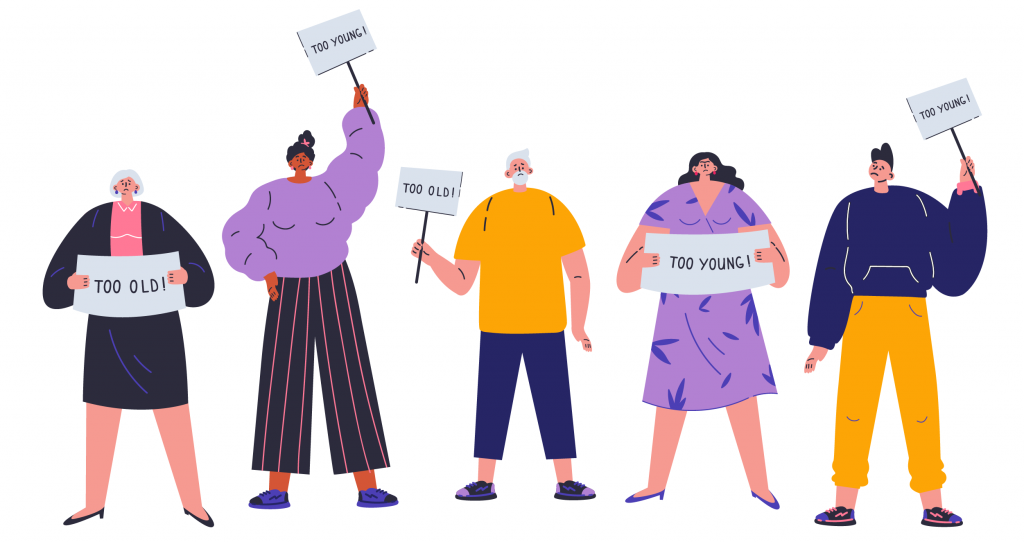The Importance of Addressing Ageism in Behavioral Health
We live in society where youth is revered, while the idea of aging is dreaded. Yet, our population is aging. In the United States, there are currently 40.3 million adults over the age of 65. By 2060, the number of Americans over the age of 65 is expected to increase to 94.7 million. Ageist attitudes are the norm. Consider for a moment, the multiple anti-aging beauty ads you see in magazines, television, and on social media. Often older adults are viewed and portrayed as incompetent, repulsive, and a social burden. With the number of older adults increasing, it is important to understand how attitudes can impact both physical and psychological well-being.
Ageism is prejudice or discrimination against a person based on their age. The term was first coined in 1969 by Robert Butler, a well-known Gerontologist. Ageism can occur at any age but is predominantly associated with older adults. When ageism occurs to older adults, it has been shown to have a negative impact on health (both physical and mental), and some research links it with earlier death. There are three types of ageism which include: institutional, interpersonal, and internalized. Institutional ageism occurs through the actions and policies of an institution that discriminate based on age. Interpersonal ageism occurs within social interactions. While internalized ageism is when a person internalizes ageist beliefs and applies them to themselves (i.e., “I’m too old to do that.”).
According to Medical News Today, “Another way to categorize ageism depends on whether a person is conscious of it or not. If they are, this is known as explicit ageism. If they are not aware of it, this is known as implicit ageism. For example, if a doctor unintentionally treats older and younger patients differently, this would be implicit ageism.” Harvard University has several Implicit Association Tests (IAT). These tests measure the strength of association between concepts (i.e., age, race, sexual orientation) and evaluations (i.e., good, bad) or stereotypes. When it comes to age, the IAT indicates that Americans have automatic preferences for young faces over old faces.

In the 2020 National Poll on Healthy Aging 82% of older Americans reported that they experienced ageism regularly. In addition, they found that:
Ageism is associated with common stereotypes which include attributing forgetting things with age, being slow, helpless, weak, fragile, unproductive, less creative, depressed, lonely, little to no sex drive, unable to adapt to new situations or technology. Studies have shown that negative stereotypes impact both cognitive and physical performance. According to Sarah Barber, this is known as of “stereotype threat”. She found through her research that stereotypes play a powerful role in how older adults perform on memory tests and cognitive tasks, lowers physical performance and motor skills, and even can decrease driving abilities and job satisfaction.
Older adults have reported that they experience “stereotype threat”. when engaging with the medical system. Research shows that approximately 17% of individuals reported experiencing stereotype threat at the doctor’s office, and 8% worry their physician is negatively evaluating them. This has been shown to have an impact on their self-reported health (both physical and mental), blood pressure, and can ultimately have an impact on the provider-patient relationship (increasing distrust and dissatisfaction).
In Rebecca Levy’s research, she takes the concept of stereotype threat a step farther with her stereotype embodiment theory. She suggests that stereotypes are adopted from the culture, and eventually become a part of the person’s identify, and their own definitions of self. She concluded that stereotypes are internalized throughout a person’s life, and they operate on an unconscious level. As a person ages, the age stereotype become embodied.
When working with older adults, it is critical to address ageism as part of a therapeutic plan. Here is a brief list of things to consider.
 It is crucial to first look at your own views on aging. What first comes to mind when you think about aging? What picture do you have in your mind when you hear the word elderly? Are you looking forward to getting older (no matter what age you are)? What stereotypes do you have about aging? Your attitude about aging may implicitly or explicitly impact how you interact and treat patients. It’s important to check your biases and stereotypes as you interact with older adults.
It is crucial to first look at your own views on aging. What first comes to mind when you think about aging? What picture do you have in your mind when you hear the word elderly? Are you looking forward to getting older (no matter what age you are)? What stereotypes do you have about aging? Your attitude about aging may implicitly or explicitly impact how you interact and treat patients. It’s important to check your biases and stereotypes as you interact with older adults.
 Explore with your client their views/attitudes about aging. Their attitude about aging is highly predictive of their own health outcomes. People who have a positive attitude about aging tend to live longer, experience fewer negative emotions, feel more confident about their bodies, have better memory function, and recovery more quickly from illness.
Explore with your client their views/attitudes about aging. Their attitude about aging is highly predictive of their own health outcomes. People who have a positive attitude about aging tend to live longer, experience fewer negative emotions, feel more confident about their bodies, have better memory function, and recovery more quickly from illness.
In a study conducted with military veterans, those who had positive views about aging had significantly lower rates of mental illness when compared with veterans who fully accepted the stereotypes. Differences were also found for suicidal ideation (5% vs. 30.1%), anxiety (3.6% vs. 34.9%), and PTSD (2% vs. 18.5%). These differences were found, even after controlling for age, combat experience, personality, and physical health.
 Work with clients to gain confidence in their own abilities (i.e., explore meaningful activities, and individual strengths). If someone gives up an activity that they love because they think they are too old, it may be useful to work with them to identify ways they can continue the activity but modify it.
Work with clients to gain confidence in their own abilities (i.e., explore meaningful activities, and individual strengths). If someone gives up an activity that they love because they think they are too old, it may be useful to work with them to identify ways they can continue the activity but modify it.
Selective optimization with compensation was first theorized by Baltes & Baltes. Within this framework, you can work with clients to identify what is most meaningful (select what they want to be doing through motivational interviewing), set realistic goals or intentions for how they can continue that activity and practice/do the activity (optimization), and make adaptations or modifications (compensation) as needed. The most famous example of the SOC model is when Arthur Rubenstein, a famous pianist, selected pieces of music that were important to him to continue playing, he practiced those pieces more intensively, and then compensated not being able to play at the same speed as when he was younger by slowing down certain parts of the music so it sounded like he was playing at a fast speed. Combining motivational interviewing with SOC can be a useful strategy when supporting older adults to continue what is meaningful to them.
 Be aware of the language you use, and treatment options you offer to an older adult. The terms elderly, frail, senile, sweetie, etc. are considered ageist language. In general, older adults preferred to be called by their name, or use neutral terms such as older person or older adult.
Be aware of the language you use, and treatment options you offer to an older adult. The terms elderly, frail, senile, sweetie, etc. are considered ageist language. In general, older adults preferred to be called by their name, or use neutral terms such as older person or older adult.
 Raise awareness about the positive mental health aspects of aging. It turns out mental illness is less prevalent among older adults; emotional regulation is more stable and psychopathology is treatable in older age. Helping to dispel myths can help to reduce internalized ageism.
Raise awareness about the positive mental health aspects of aging. It turns out mental illness is less prevalent among older adults; emotional regulation is more stable and psychopathology is treatable in older age. Helping to dispel myths can help to reduce internalized ageism.
The gap between mental needs and the needs of older adults continues to widen. Half of fellowship positions in geriatric psychiatry go unfilled each year, and only 4.2% of psychologist focus on geriatric care in clinical practice. Within CACREP standards older adults are not referenced. Lack of interest in the field is associated with lack of multidisciplinary gerontology programs, the absence of gerontological content within textbooks, few faculty trained in gerontology, misconception about employment opportunities, and little to no discussion of this population within coursework.
To date, little research has been conducted on how best to support older adults within the behavioral health field. With the vast number of older adults only increasing in our society, more research needs to be done on how best to treat older adults and support life transitions. If we can combat ageism within direct clinical services, provider education, research and public policy, we have the opportunity to counteract ageism’s harmful effects and promote more positive perceptions of growing older.
Additional resources may be found on the CASAT OnDemand Resources & Downloads page.
This article was developed by Heather Haslem, M.S. Feel free to use, link to, or distribute this information. A link to our site and attribution would be much appreciated.
References:
Brown, L. (2020, February 21). 5 examples of everyday ageism. SDSU Extension. Retrieved September 11, 2022, from https://extension.sdstate.edu/5-examples-everyday-ageism
Fullen, M. C. (2018). Ageism and the counseling profession: Causes, consequences, and methods for Counteraction. The Professional Counselor, 8(2), 104–114. https://doi.org/10.15241/mcf.8.2.104
Hardin, K. (2019). Ageism and mental health – Ohio psychological association. Ohio Psychological Society. Retrieved September 11, 2022, from https://ohpsych.org/news/news.asp?id=432688
Healthy Aging Magazine. (2019). Celebrate September healthy aging month by reinventing yourself. Healthy Aging®. Retrieved September 11, 2022, from https://healthyaging.net/healthy-aging-month/celebrate-september-is-healthy-aging-month-reinvent-yourself/
Lyons, A., Alba, B., Heywood, W., Fileborn, B., Minichiello, V., Barrett, C., Hinchliff, S., Malta, S., & Dow, B. (2018). Experiences of ageism and the mental health of older adults. Aging & mental health, 22(11), 1456–1464. https://doi.org/10.1080/13607863.2017.1364347
MediLexicon International. (2021). What is ageism? types, examples, and impact on health. Medical News Today. Retrieved September 19, 2022, from https://www.medicalnewstoday.com/articles/ageism
Blog Post Tags:
Related Blog Posts
Related Learning Labs
Related Resources
.
- Buscar Tratamiento de Calidad para Trastornos de uso de Sustancia (Finding Quality Treatment for Substance Use Disorders Spanish Version)
- Finding Quality Treatment for Substance Use Disorders
- Focus On Prevention: Strategies and Programs to Prevent Substance Use
- Monthly Variation in Substance Use Initiation Among Full-Time College Students
- The National Survey on Drug Use and Health (NSDUH) Report: Monthly Variation in Substance Use Initiation Among Adolescents








